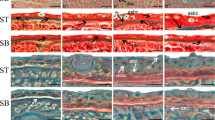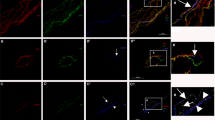Summary
The granular glands in Xenopus laevis skin are known to contain large quantities of biogenic amines and bioactive peptides which closely resemble mammalian brain-gut peptides. We studied the development of glands producing 5-hydroxytryptamine (5-HT) and caerulein using immunohistochemistry, HPLC-fluorometric systems and RIA. The immunoreactivities of 5-HT and caerulein were first detected in the spherical gland rudiments in the stratum spongiosum at St. 58 (Nieuwkoop and Faber stage), or at the beginning of metamorphosis. Both immunoreactivities appeared in the same rudiment at the same time. Some of the gland rudiments have a small lumen filled with both immunoreactive materials at St. 58–59. During the rest of the metamorphic period, the glands grow in size, accumulating immunoreactive materials in the lumen. The concentrations of 5-HT and caerulein in the skin of tadpoles were below 1 ng per mg wet tissue at St. 58–59, increased as metamorphosis proceeded and reached 63 and 134 ng per mg wet tissue at St. 66, or at the end of metamorphosis, respectively. The amphibian granular glands where large quantities of biogenic amines and hormone-like peptides are rapidly synthesized may provide a useful model for the study of the development of amine- and peptide-producing cells including neurons and paraneurons.
Similar content being viewed by others
References
Anastasi A, Erspamer V, Endeam R (1968) Isolation and amino acid sequence of caerulein, the active decapeptide of the skin of Hyla caerulea. Arch Biochem Biophys 125:57–68
Anastasi A, Bertaccini G, Cei JM, De Caro G, Erspamer V, Impicciatore M, Roseghini M (1970) Presence of caerulein in extracts of the skin of Leptodactylus pentadactylus labryinthicus and Xenopus laevis. Br J Pharmacol 38:221–228
Andreu D, Ashauer H, Kreil G, Merrifield RB (1985) Solidphase synthesis of PYL and isolation of its natural counterpart, PGLa (PYLa-(4–24)) from skin secretion of Xenopus laevis. Eur J Biochem 149:531–535
Araki K, Tachibana S, Uchiyama T, Nakajima T, Yasuhara T (1973) Isolation and structure of a new active peptide “Xenopsin” on the smooth muscle, especially on a strip of fundus from rat stomach, from the skin of Xenopus laevis. Chem Pharmacol Bull 21:281–284
Bennett GW, Ball M, Clothier RH, Marsden CA (1981) Location and release of TRH and 5-HT from amphibian skin. Cell Biol Int Rep 5:151–158
Bovbjerg AM (1963) Development of the glands of the dermal plicae in Rana pipiens. J Morphol 113:231–243
Carraway R, Ruane SE, Feurle GE, Taylor S (1982) Amphibian neurotensin (NT) is not Xenopsin (XP): Dual presence of NT-like and XP-like peptides in various amphibia. Endocrinology 110:1094–1101
Delfino G, Brizzi R, Calloni C (1985) Dermo-epithelial interactions during the development of cutaneous gland anlagen in amphibia: A light and electron microscope study on several species with some cytochemical findings. Z Mikrosk Anat Forsch, Leipzig 99:225–253
Delfino G, Brizzi R, Calloni C (1982) Development of cutaneous glands in Salamandrina terdigitata (Lacepede, 1788) (amphibia: Urodela); Findings by light and electron microscopy. Z Mikrosk Anat Forsch, Leipzig 96:948–971
Dimaline R (1983) Is caerulein amphibian CCK? Peptides 4:457–462
Dockray GJ, Hopkins CR (1975) Caerulein secretion by dermal glands in Xenopus laevis. J Cell Biol 64:724–733
Dodd MHI, Dodd JM (1976) The biology of metamorphosis. In: Lofts BA (ed) Physiology of the Amphibia. Academic Press, New York, pp 467–599
Erspamer V (1983) Amphibian skin peptides in mammals-looking ahead. Trends Neuro Sci 6:200–201
Flucher BE, Lenglachner-Bachinger C, Pohlhammer K, Adam H, Mollay C (1986) Skin peptides in Xenopus laevis: Morphological requirements for precursor processing in developing and regeneration granular skin gland. J Cell Biol 103:2299–2309
Fujita T (1983) Messenger substances of neurons and paraneurons: The chemical nature and the routes and ranges of their transport to targets. Biomed Res 4:239–256
Hoffmann W, Bach TC, Seliger H, Kreil G (1983) Biosynthesis of caerulein in the skin of Xenopus laevis: partial sequences of precursors as deduced from cDNA clones. EMBO J 2:111–114
Hökfelt T, Millhorn D, Seroogy K, Tsuruo Y, Ceccatelli S, Lindh B, Meister B, Melander T, Schalling M, Bartfai T, Terenius L (1987) Coexistence of peptides with classical neurotransmitters. Experientia 43:768–780
Iguchi K, Yanaihara C, Kubota M, Iwanaga T, Fujita T, Matsuo Y, Miyoshi A, Yanaihara N (1983) Porcine cholecystokinin-33 amino-terminal specific radioimmunoassay developed with synthetic porcine cholecystokinin-33 amino-terminal heptacosapeptide. Biomed Res 4 [Suppl] 189–196
Inselvini M (1975) First appearance of caerulein during the development of Xenopus laevis. Gen Pharmacol 6:215–217
King J, Millar RP (1981) TRH, GH-RIH and LH-RH in Metamorphosing Xenopus laevis. Gen Comp Endocrinol 44:20–27
Kollros J, Kaltenbach JC (1952) Metamorphosis of larval skin in Rana pipiens. Physiol Zool 25:163–170
McGarry MP, Vanable JW Jr (1969) The role of thyroxine in the formation of the gland rudiments in the skin of Xenopus laevis. Dev Biol 20:426–434
Nieuwkoop PD, Faber J (1956) Normal table of Xenopus laevis (Daudin). North-Holland Publ. Co, Amsterdam
Pearse AGE (1976) Peptides in brain and intestine. Nature 262:92–94
Richter K, Kawashima E, Egger R, Kreil G (1984) Biosynthesis of thyrotropin releasing hormone in the skin of Xenopus laevis: partial sequence of the precursor deduced from cloned cDNA. EMBO J 3:617–621
Solcia E, Usellini L, Buffa R, Rindi G, Villani L, Zampatti C, Silini E (1987) Endocrine cells producing regulatory peptides. Experientia 43:839–850
Sternberger LA, Jardy PH Jr, Cuculis JJ, Meyers HG (1970) Unlabeled antibody-enzyme method of immunocytochemistry. Preparation and properties of soluble antigen-antibody complex (horseradish peroxidase-antihorseradish peroxidase) and its use in the identification of spirochtes. J Histochem Cytochem 18:315–333
Vacca LL, Rosario SL, Zimmerman EA, Tomashefsky P, Po-Ying NG, Hsu KG (1975) Application of immunoperoxidase technique to localize horseradish peroxidase-tracer in the central nervous system. J Histochem Cytochem 23:208–215
Vanable WJ Jr (1964) Granular gland development during Xenopus laevis metamorphosis. Dev Biol 10:331–357
Verma K (1965) Regional differences in skin gland differentiation in Rana pipiens. J Morphol 117:73–86
Wakabayashi T, Kato H, Tachibana S (1984) An unusual repetitive structure of caerulein mRNA from the skin of Xenopus laevis. Gene 31:295–299
Wakabayashi T, Kato H, Tachibana S (1985) Complete nucleotide sequence of mRNA for caerulein precursor from Xenopus skin: the mRNA contains an unusual repetitive structure. Nucleic Acids Res 13:1817–1828
Yoshie S, Iwanaga T, Fujita T (1985) Coexistence of bombesin and 5-hydroxytryptamine in the cutaneous gland of the frog, Bombiana orientalis. Cell Tissue Res 239:25–29
Zasloff M (1987) Magainins, a class of antimicrobial peptides from Xenopus skin: Isolation, characterization of two active form, and partial cDNA sequence of a precursor. Proc Natl Acad Sci USA 84:5449–5453
Author information
Authors and Affiliations
Rights and permissions
About this article
Cite this article
Seki, T., Kikuyama, S. & Yanaihara, N. Development of Xenopus laevis skin glands producing 5-hydroxytryptamine and caerulein. Cell Tissue Res. 258, 483–489 (1989). https://doi.org/10.1007/BF00218860
Accepted:
Issue Date:
DOI: https://doi.org/10.1007/BF00218860




